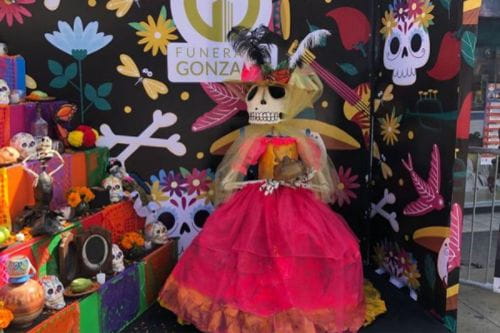Adrian Carmona may spend much of his time teaching art at Centro de Enseñanza Montessori in Tijuana, Mexico, but he also shares his passion for traditional Mexican art beyond the walls of his classroom.
Honoring the Dead and Mexican Traditions
When Adrian was selected to be just one of twelve local artists to contribute to Tijuana’s Festival of Altars and Catrinas for the city-wide Day of the Dead celebration, he was honored to have a platform to share his love for “Mexico’s magnificent and beautiful culture.”
Challenged with creating an altar for the event, Adrian crafted the vibrant structure with wood, clay, paper flowers, papier-mâché, and recycled materials.
His altar featured traditional alebrijes and a large-scale representation of La Catrina, all made from wire, newspaper, and paint, with techniques that Adrian frequently introduces to his students as a way of honoring traditional Mexican folk art.
The La Catrina figure is a widely recognized image in Day of the Dead celebrations, representing “The Lady of Death.” While the iconic Día de los Muertos character has a complicated backstory, today she serves as a reminder of human mortality.
Surrounding the altar, Adrian included numerous alebrijes. The papier-mâché mythical creatures were first created by Pedro Linares Lopez, a cartonero (or papier-mâché crafter) from Mexico City. Today, alebrijes are often carved out of wood, though Adrian created his using the original medium.
Surrounding the figures are other traditional Día de los Muertos items: copal el papel picado, marigold flowers, traditional Mexican food, and candles.
Adrian’s offering, along with the other 11 altars, were displayed along Avenida Revolución, Tijuana’s main street. Visitors could use a QR code to follow the route and learn about the details of each altar.
Día de los Muertos, a two-day Mexican holiday celebrated on November 1 and 2, honors the bridging of life and death and allows families to reconnect with ancestors and loved ones.
Art Education as a Gateway to Appreciating Culture
As an art educator who is deeply committed to sharing his love for traditional Mexican culture, it’s not surprising that Adrian was asked to contribute to the annual festival.
Adrian teaches art to 2.5 – 12 year-olds at Centro de Enseñanza Montessori, where he aims to instill a passion for creativity and culture in his students.
In the classroom, he combines his love of creating with recycled materials and traditional Mexican art techniques, often using art history as his muse.
Adrian roots his lessons in the artistic legacies of world-renowned Mexican artists such as Diego Rivera, José Guadalupe Posadas, and Frida Kahlo. By using famous Mexican artists as an inspiration for projects, Adrian creates a sense of cultural pride in the children that he supports. It’s his way of continuing his country’s traditions and passing the artistic torch to the next generation.
Perhaps one of the children in his classroom will someday be selected for the same honor: creating an altar that celebrates Tijuana’s ancestors and the vibrant legacy of Mexican traditions.
About the Author
 |
Kira Hinkle (she/her) is a Montessori educator turned freelance writer. She is AMS credentialed (Elementary I). Contact her at kirahinkle@gmail.com. |
The opinions expressed in Montessori Life are those of the authors and do not necessarily represent the position of AMS.


